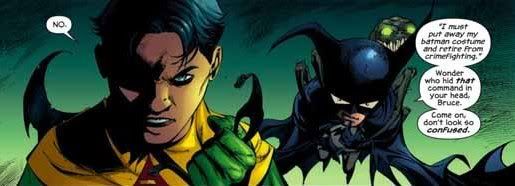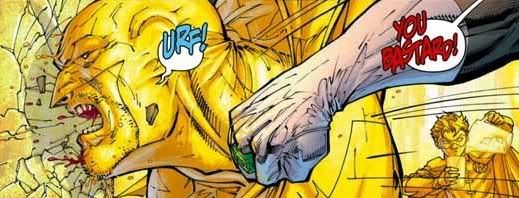Batman, You're GOOD and OKAY With Me: Jog in Gotham on 2/27
/![]() In which we reach nearly the same grade in very different ways, although even when the grade is the same, its never really the same, you know?
Batman #674: In which writer Grant Morrison is kind enough to provide an 'explanation issue' for most of what's been going on across his run. Honestly, he maybe goes a bit far with it - I sure could have done without Batman putting together the pieces of The Mystery of the Three Fake Batmen via captions and flashbacks, immediately followed by Commissioner Gordon and a beat cop repeating exactly the same information via dialogue, in case anyone didn't get it the first time around. I shouldn't complain, though - too often for me, this run has seemed less an actual story than Grant Morrison inviting me to flip through his notebooks, after which I think, "gee, this'll be pretty neat once he actually writes it!" For a lot of these chapters, everything about the comic has been interesting except, sadly, for the comic.
In which we reach nearly the same grade in very different ways, although even when the grade is the same, its never really the same, you know?
Batman #674: In which writer Grant Morrison is kind enough to provide an 'explanation issue' for most of what's been going on across his run. Honestly, he maybe goes a bit far with it - I sure could have done without Batman putting together the pieces of The Mystery of the Three Fake Batmen via captions and flashbacks, immediately followed by Commissioner Gordon and a beat cop repeating exactly the same information via dialogue, in case anyone didn't get it the first time around. I shouldn't complain, though - too often for me, this run has seemed less an actual story than Grant Morrison inviting me to flip through his notebooks, after which I think, "gee, this'll be pretty neat once he actually writes it!" For a lot of these chapters, everything about the comic has been interesting except, sadly, for the comic.

Still, there's been some fairly great moments (with one truly front-to-back fine release in #666), and issues like this leave me confident that things may yet gel in the end. There's dramatic build in this one, a little detective puzzling and narrow escaping, and a smart, minimally sketched look at villain Doctor Hurt, an Evil Creator seemingly straight out of Seven Soldiers, who accomplishes much mischief with his paranoia-fueled knockoff Batmen.
At this point, it's not exactly reading deep to see this run as a mirror image of Morrison's work on All Star Superman: the history of each series is marshaled, the prime threats are alternate versions of the main heroes, and hell - both are even going to climax with the title characters facing down death. And the second-most interesting thing about Batman is that Morrison is mostly throwing concerns for serialization and easy access to the wind in order to whip up a big, sloppy History of the Bat around Bruce Wayne's struggle toward the future, bedeviled primarily by The Gun-Toting Batman or A Knightfall-ish Batman But Also Bane, along with a son he never knew about, the result of a storyline he'd seemed to forget about. Aren't they all imaginary stories?
In contrast, All Star Superman is Morrison on his 'best' behavior, matching the goodness and light of Superman with easy-access, one-or-two-issue stories that often follow a template for confrontation and (mostly) peaceable resolution -- to a somewhat dulling effect, recently -- while keeping the narrative squarely on character interactions. It's a vastly less difficult superhero book, and maybe part of that's because Morrison isn't under the shared-universe gun.
Which brings me around to the most interesting about Batman: isn't it something that the out-of-continuity All Star Superman sees its kindly hero always striving to make good with his doppelgangers and bits of history, while the in-continuity Batman has its grittier struggling and bleeding against mostly the same forces, as if the crap from the past might yet rise up and ruin all he's done, transforming him (if only through substitution, a la Damian in #666) into something awful. This wouldn't be the first time Morrison's fretted metaphorically over where the shared-universe characters he works on will go once he's gone -- Seven Soldiers has an element of that, and even a creator-owned project like Seaguy touches on it -- but it's especially striking on such a high-profile book, with such a high-profile contrast running at the same time.
GOOD issue here, hopefully clawing its way up toward something really whole and compelling.
(and meanwhile, on the other side of Gotham...)
All Star Batman and Robin, the Boy Wonder #9: It's nice to see this series getting past its extra-long setup for a one-off issue; its strengths and weaknesses definitely stand out more clearly in the short form.
The plot is quite simple: cackling tricksters Batman and Robin(, the Boy Wonder) want to get the rest of the nascent DCU's superheroes off their back, so they confront Green Lantern -- who, by writer Frank Miller's take, is the dumbest, lamest, most ridiculous bag of nonsense ever to wear a superhero costume -- by painting themselves yellow from head to toe and inviting him to a talk in a yellow room, at which point they taunt him while drinking tall glasses of lemonade, eating what look to be corn chips, and reading comics featuring... wait for it... the Yellow Kid. It all goes well until the not-yet Wonderful Boy accidentally crunches Hal's throat, forcing everyone to break character and perform emergency surgery in the Yellow Room.

As usual, Miller's jokes range from corny gags to amusing throwaway lines to characterizations seemingly custom-designed to annoy large portions of the DC comics readership. It's also pretty self-indulgent in a 'writerly' sense, in that pages often groan under reams of words - bubbles, captions, newspaper clippings, etc. I wonder if the creative team has become acutely aware of this, though, since penciller Jim Lee is now detailing sight gags and the like, all in his hewn-from-marble approach with longtime inker Scott Williams. This density of visual information might also double as a way to compensate for the fact that over a third of the issue is splash pages of some type.
Aw, but All Star Batman wouldn't be itself if it wasn't so loud and gregarious, and somewhat nasty - the Dynamic Duo's 'daddy hits me because he loves me' interdependence is extra-queasy, although Miller's portrayal of early superheroes and supervillains trying out personas and playacting their way into legend is getting oddly compelling. OKAY, if you will.
And god, those last five pages where All Star Batman gets serious and Our Heroes cradle each other while shedding manly tears over all they've lost in life... has Miller been reading Kazuo Koike again?!











